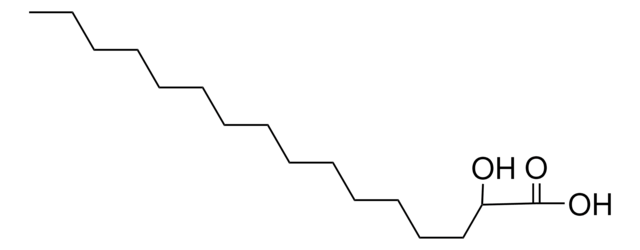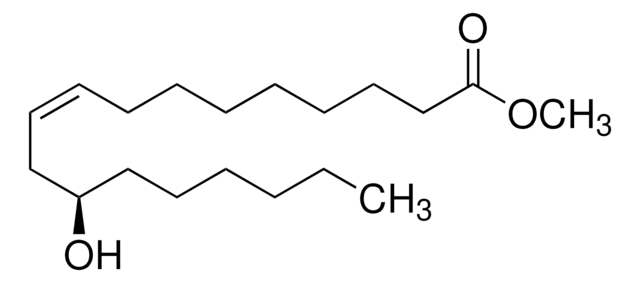SML0256
2OHOA
≥98% (HPLC)
Sinonimo/i:
(9Z)-2-Hydroxy-9-octadecenoic acid; cis-2-Hydroxy-9-octadecenoic acid, 2-Hydroxy Oleic Acid, Minerval
About This Item
Prodotti consigliati
Saggio
≥98% (HPLC)
Condizioni di stoccaggio
protect from light
Colore
white to tan
Solubilità
DMSO: >20 mg/mL
Temperatura di conservazione
room temp
Stringa SMILE
CCCCCCCC\C=C/CCCCCCC(O)C(O)=O
InChI
1S/C18H34O3/c1-2-3-4-5-6-7-8-9-10-11-12-13-14-15-16-17(19)18(20)21/h9-10,17,19H,2-8,11-16H2,1H3,(H,20,21)/b10-9-
JBSOOFITVPOOSY-KTKRTIGZSA-N
Applicazioni
- a modulator of the sphingolipid and glycerophospholipid pathway to study its effects on myelination in mice Charcot–Marie–Tooth type 1A (CMT1A) myelinopathy and myelinating dorsal root ganglia cultures
- in biophysical studies to study its effects on artificial membranes
- to study its interactions with major membrane lipid films
Azioni biochim/fisiol
Avvertenze
Danger
Indicazioni di pericolo
Consigli di prudenza
Classi di pericolo
Eye Dam. 1
Codice della classe di stoccaggio
11 - Combustible Solids
Classe di pericolosità dell'acqua (WGK)
WGK 3
Punto d’infiammabilità (°F)
Not applicable
Punto d’infiammabilità (°C)
Not applicable
Certificati d'analisi (COA)
Cerca il Certificati d'analisi (COA) digitando il numero di lotto/batch corrispondente. I numeri di lotto o di batch sono stampati sull'etichetta dei prodotti dopo la parola ‘Lotto’ o ‘Batch’.
Possiedi già questo prodotto?
I documenti relativi ai prodotti acquistati recentemente sono disponibili nell’Archivio dei documenti.
I clienti hanno visto anche
Il team dei nostri ricercatori vanta grande esperienza in tutte le aree della ricerca quali Life Science, scienza dei materiali, sintesi chimica, cromatografia, discipline analitiche, ecc..
Contatta l'Assistenza Tecnica.













